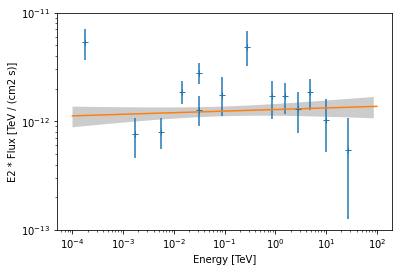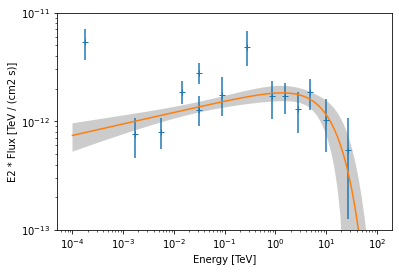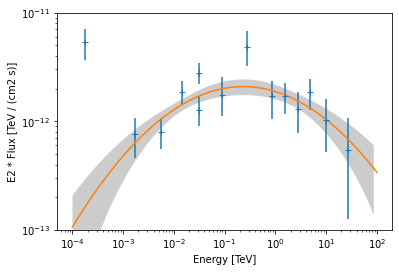This is a fixed-text formatted version of a Jupyter notebook
You can contribute with your own notebooks in this GitHub repository.
Source files: sed_fitting.ipynb | sed_fitting.py
Flux point fitting in Gammapy¶
Prerequisites¶
Some knowledge about retrieving information from catalogs, see the catalogs tutorial
Context¶
Some high level studies do not rely on reduced datasets with their IRFs but directly on higher level products such as flux points. This is not ideal because flux points already contain some hypothesis for the underlying spectral shape and the uncertainties they carry are usually simplified (e.g. symmetric gaussian errors). Yet, this is an efficient way to combine heterogeneous data.
Objective: fit spectral models to combined Fermi-LAT and IACT flux points.
Proposed approach¶
Here we will load, the spectral points from Fermi-LAT and TeV catalogs and fit them with various spectral models to find the best representation of the wide band spectrum.
The central class we’re going to use for this example analysis is:
In addition we will work with the following data classes:
And the following spectral model classes:
Setup¶
Let us start with the usual IPython notebook and Python imports:
[1]:
%matplotlib inline
[2]:
import numpy as np
from astropy import units as u
from gammapy.modeling.models import (
PowerLawSpectralModel,
ExpCutoffPowerLawSpectralModel,
LogParabolaSpectralModel,
SkyModel,
)
from gammapy.estimators import FluxPoints
from gammapy.datasets import FluxPointsDataset
from gammapy.catalog import CATALOG_REGISTRY
from gammapy.modeling import Fit
Load spectral points¶
For this analysis we choose to work with the source ‘HESS J1507-622’ and the associated Fermi-LAT sources ‘3FGL J1506.6-6219’ and ‘3FHL J1507.9-6228e’. We load the source catalogs, and then access source of interest by name:
[3]:
catalog_3fgl = CATALOG_REGISTRY.get_cls("3fgl")()
catalog_3fhl = CATALOG_REGISTRY.get_cls("3fhl")()
catalog_gammacat = CATALOG_REGISTRY.get_cls("gamma-cat")()
[4]:
source_fermi_3fgl = catalog_3fgl["3FGL J1506.6-6219"]
source_fermi_3fhl = catalog_3fhl["3FHL J1507.9-6228e"]
source_gammacat = catalog_gammacat["HESS J1507-622"]
The corresponding flux points data can be accessed with .flux_points attribute:
[5]:
flux_points_gammacat = source_gammacat.flux_points
flux_points_gammacat.table
[5]:
| e_ref | dnde | dnde_errn | dnde_errp |
|---|---|---|---|
| TeV | 1 / (cm2 s TeV) | 1 / (cm2 s TeV) | 1 / (cm2 s TeV) |
| float32 | float32 | float32 | float32 |
| 0.8609 | 2.29119e-12 | 8.70543e-13 | 8.95502e-13 |
| 1.56151 | 6.98172e-13 | 2.20354e-13 | 2.30407e-13 |
| 2.76375 | 1.69062e-13 | 6.7587e-14 | 7.18838e-14 |
| 4.8916 | 7.72925e-14 | 2.40132e-14 | 2.60749e-14 |
| 9.98858 | 1.03253e-14 | 5.06315e-15 | 5.64195e-15 |
| 27.0403 | 7.44987e-16 | 5.72089e-16 | 7.25999e-16 |
In the Fermi-LAT catalogs, integral flux points are given. Currently the flux point fitter only works with differential flux points, so we apply the conversion here.
[6]:
flux_points_3fgl = source_fermi_3fgl.flux_points.to_sed_type(
sed_type="dnde", model=source_fermi_3fgl.spectral_model()
)
flux_points_3fhl = source_fermi_3fhl.flux_points.to_sed_type(
sed_type="dnde", model=source_fermi_3fhl.spectral_model()
)
Finally we stack the flux points into a single gammapy.estimators.FluxPoints object and drop the upper limit values, because currently we can’t handle them in the fit:
[7]:
# Stack flux point tables
flux_points = FluxPoints.stack(
[flux_points_gammacat, flux_points_3fhl, flux_points_3fgl]
)
t = flux_points.table
t["dnde_err"] = 0.5 * (t["dnde_errn"] + t["dnde_errp"])
# Remove upper limit points, where `dnde_errn = nan`
is_ul = np.isfinite(t["dnde_err"])
flux_points = FluxPoints(t[is_ul])
flux_points
[7]:
FluxPoints(sed_type='dnde', n_points=14)
Power Law Fit¶
First we start with fitting a simple gammapy.modeling.models.PowerLawSpectralModel.
[8]:
pwl = PowerLawSpectralModel(
index=2, amplitude="1e-12 cm-2 s-1 TeV-1", reference="1 TeV"
)
model = SkyModel(spectral_model=pwl)
After creating the model we run the fit by passing the 'flux_points' and 'model' objects:
[9]:
dataset_pwl = FluxPointsDataset(model, flux_points)
fitter = Fit([dataset_pwl])
result_pwl = fitter.run()
And print the result:
[10]:
print(result_pwl)
OptimizeResult
backend : minuit
method : minuit
success : True
message : Optimization terminated successfully.
nfev : 40
total stat : 28.29
[11]:
print(pwl)
PowerLawSpectralModel
name value unit min max frozen error
--------- ---------- -------------- --- --- ------ ---------
index 1.9854e+00 nan nan False 2.832e-02
amplitude 1.2828e-12 cm-2 s-1 TeV-1 nan nan False 1.599e-13
reference 1.0000e+00 TeV nan nan True 0.000e+00
Finally we plot the data points and the best fit model:
[12]:
ax = flux_points.plot(energy_power=2)
pwl.plot(energy_range=[1e-4, 1e2] * u.TeV, ax=ax, energy_power=2)
pwl.plot_error(energy_range=[1e-4, 1e2] * u.TeV, ax=ax, energy_power=2)
ax.set_ylim(1e-13, 1e-11);
None

Exponential Cut-Off Powerlaw Fit¶
Next we fit an gammapy.modeling.models.ExpCutoffPowerLawSpectralModel law to the data.
[13]:
ecpl = ExpCutoffPowerLawSpectralModel(
index=1.8,
amplitude="2e-12 cm-2 s-1 TeV-1",
reference="1 TeV",
lambda_="0.1 TeV-1",
)
model = SkyModel(spectral_model=ecpl)
We run the fitter again by passing the flux points and the model instance:
[14]:
dataset_ecpl = FluxPointsDataset(model, flux_points)
fitter = Fit([dataset_ecpl])
result_ecpl = fitter.run()
print(ecpl)
ExpCutoffPowerLawSpectralModel
name value unit min max frozen error
--------- ---------- -------------- --- --- ------ ---------
index 1.8943e+00 nan nan False 4.700e-02
amplitude 1.9621e-12 cm-2 s-1 TeV-1 nan nan False 3.899e-13
reference 1.0000e+00 TeV nan nan True 0.000e+00
lambda_ 7.7656e-02 TeV-1 nan nan False 5.252e-02
alpha 1.0000e+00 nan nan True 0.000e+00
We plot the data and best fit model:
[15]:
ax = flux_points.plot(energy_power=2)
ecpl.plot(energy_range=[1e-4, 1e2] * u.TeV, ax=ax, energy_power=2)
ecpl.plot_error(energy_range=[1e-4, 1e2] * u.TeV, ax=ax, energy_power=2)
ax.set_ylim(1e-13, 1e-11)
None
[15]:
(1e-13, 1e-11)

Log-Parabola Fit¶
Finally we try to fit a gammapy.modeling.models.LogParabolaSpectralModel model:
[16]:
log_parabola = LogParabolaSpectralModel(
alpha=2, amplitude="1e-12 cm-2 s-1 TeV-1", reference="1 TeV", beta=0.1
)
model = SkyModel(spectral_model=log_parabola)
[17]:
dataset_log_parabola = FluxPointsDataset(model, flux_points)
fitter = Fit([dataset_log_parabola])
result_log_parabola = fitter.run()
print(log_parabola)
LogParabolaSpectralModel
name value unit min max frozen error
--------- ---------- -------------- --- --- ------ ---------
amplitude 1.8768e-12 cm-2 s-1 TeV-1 nan nan False 2.819e-13
reference 1.0000e+00 TeV nan nan True 0.000e+00
alpha 2.1437e+00 nan nan False 7.273e-02
beta 4.9355e-02 nan nan False 1.823e-02
[18]:
ax = flux_points.plot(energy_power=2)
log_parabola.plot(energy_range=[1e-4, 1e2] * u.TeV, ax=ax, energy_power=2)
log_parabola.plot_error(
energy_range=[1e-4, 1e2] * u.TeV, ax=ax, energy_power=2
)
ax.set_ylim(1e-13, 1e-11);
None

Exercises¶
Fit a
gammapy.modeling.models.PowerLaw2SpectralModelandgammapy.modeling.models.ExpCutoffPowerLaw3FGLSpectralModelto the same data.Fit a
gammapy.modeling.models.ExpCutoffPowerLawSpectralModelmodel to Vela X (‘HESS J0835-455’) only and check if the best fit values correspond to the values given in the Gammacat catalog
What next?¶
This was an introduction to SED fitting in Gammapy.
If you would like to learn how to perform a full Poisson maximum likelihood spectral fit, please check out the spectrum analysis tutorial.
To learn how to combine heterogeneous datasets to perform a multi-instrument forward-folding fit see the MWL analysis tutorial
[ ]:
